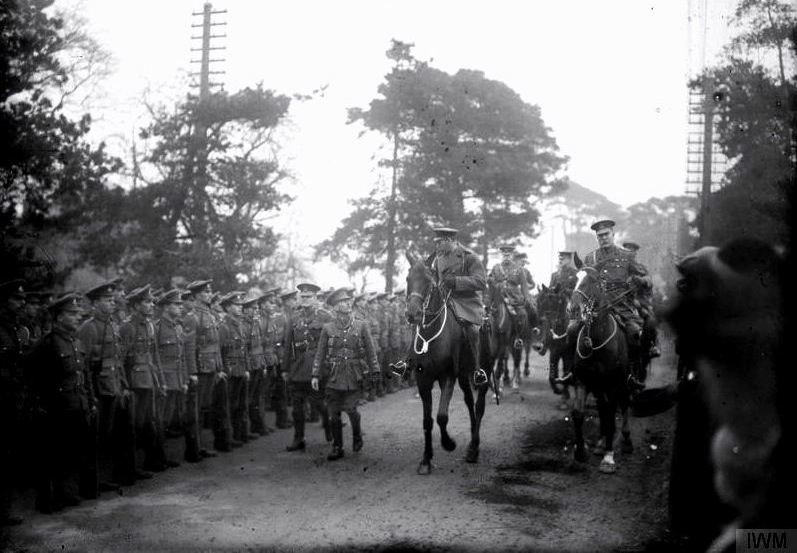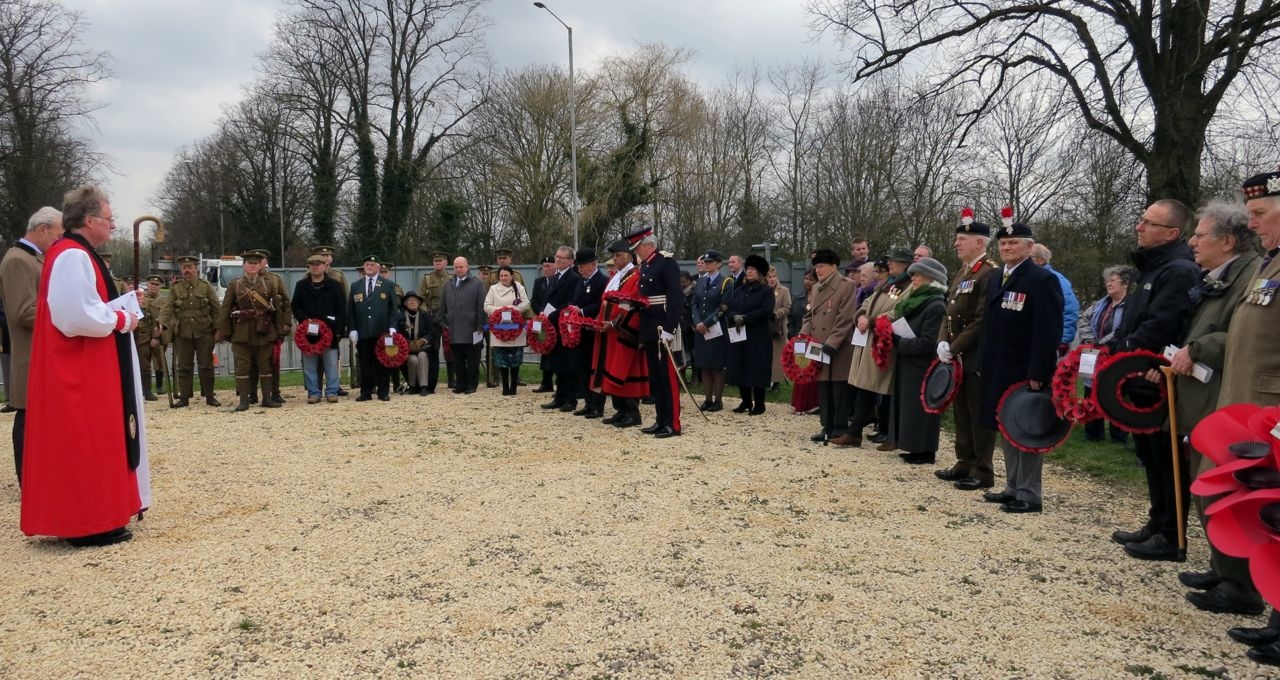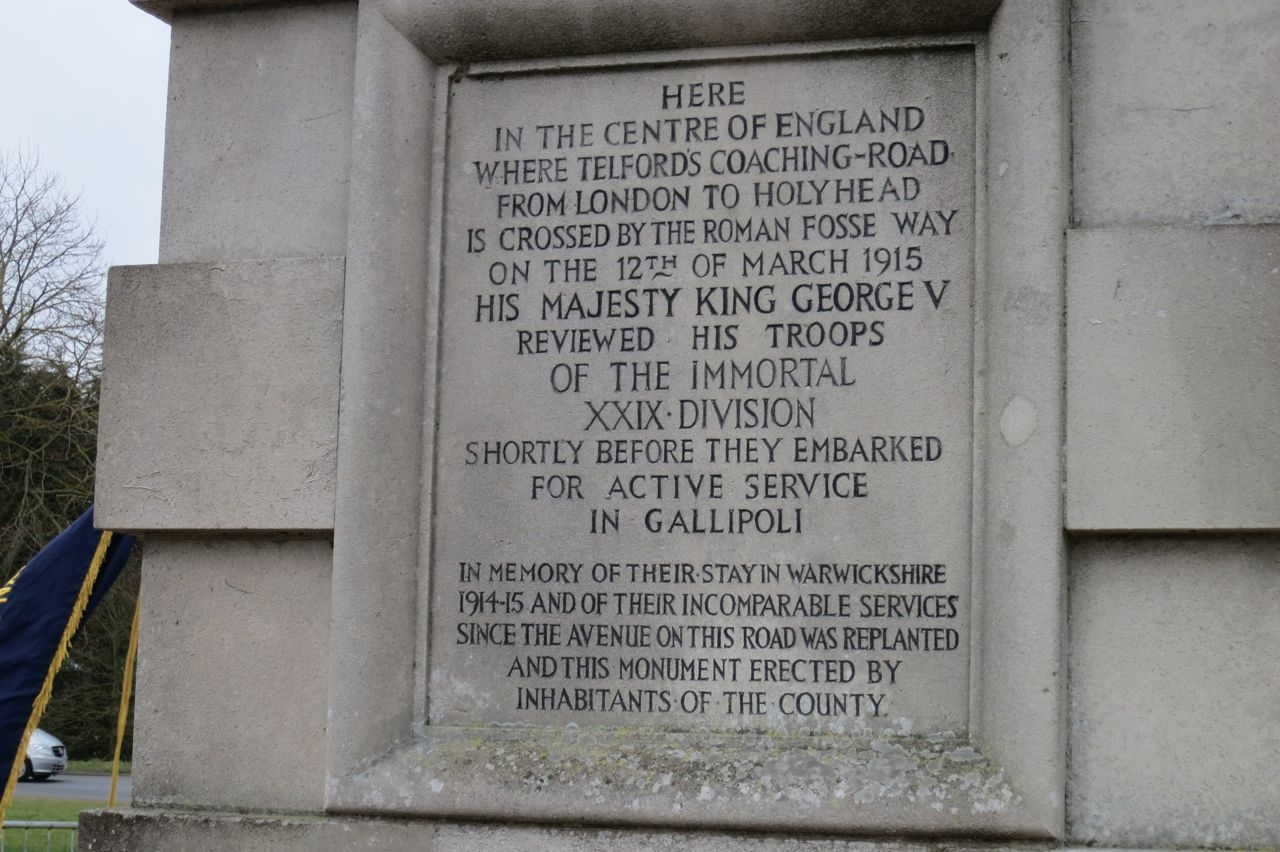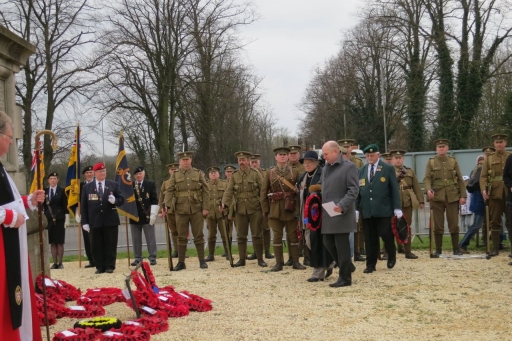A ceremony has been held in Warwickshire to mark the centenary of thousands of British troops parading past King George V before they left for Gallipoli. Lyn Edmonds, of the Gallipoli Association, tells their story.
One hundred years ago, on 12th March 1915, one of the most impressive local sights of World War I took place near a small Warwickshire village in the centre of England when approximately 16,000 soldiers paraded along the London Road (now the A45) near the small village of Stretton-on-Dunsmore as King George V took the salute.
This line of troops was over two miles long and they were the men of the newly formed 29th Division who were demonstrating their readiness for war.
The troops had been billeted in Warwickshire and north Oxfordshire during the early part of 1915. Although some were drawn from the Territorial Force, most were part of Britain’s regular army and had recently returned from overseas service in the British Empire. The King was greeted by cheers from a small crowd of locals estimated at about 1,000, although the visit had not been announced due to wartime censorship.
 King George V inspecting the British Army’s 29th Division, Dunchurch, Warwickshire, March 12th 1915 (Photo: © IWM Q 69476)
King George V inspecting the British Army’s 29th Division, Dunchurch, Warwickshire, March 12th 1915 (Photo: © IWM Q 69476)
On Sunday, 15th March 2015, just over 100 years later representatives of the 12 regiments and several descendants of those men came together at a commemorative service to remember their forebears and all those men of the 29th Division who left England for Gallipoli in 1915, many of them never to return. This service was organised by the Gallipoli Association and Rugby Borough Council.
The difficulties of holding a commemorative service on a busy road traffic island meant that the service was limited to approximately 100 attendees by invitation only and could not be widely publicised – a striking parallel with 1915.
Those representing the regiments of the 29th Division included regimental associations and museums from all around the UK and Ireland, as well as serving personnel of the Royal Welsh Fusiliers who were there to honour the 2nd Bn, The South Wales Borderers.
The Lord-Lieutenant of Warwickshire, Mr.Timothy Cox, attended the service and laid a wreath, and the Bishop of Warwick, the Rt. Revd John Stroyan conducted the service. Wreaths were also laid by the Chairman of the Gallipoli Association, Captain Christopher Fagan, the Mayor of Rugby, and the MP for Rugby and other local dignitaries.

(Photo: Keith Edmonds, Gallipoli Association)
Other wreath layers included descendants of men who were inspected by the King on that day in March 1915. Mrs Anne McCarthy was there to remember her father Cuthbert H T Lucas, the Brigade Major of the 87th Brigade, as was Mr Patrick Hayes whose father was one the 1st Battalion Royal Dublin Fusiliers.
The event was coordinated by two members of the Gallipoli Association who themselves had forebears there in 1915. Mr James Watson Smith’s Great Uncle was Col E. P. Smith who was commanding the 17th Brigade RFA and Mrs Lyn Edmonds’ grandfather was Pte Benjamin Hurt, a Royal Dublin Fusilier. The occasion was completed by a civic reception, hosted by Rugby Borough Council.
In 1915 the troops of the 29th Division were made up from twelve infantry Battalions: 86th Infantry Brigade (2nd Bn, The Royal Fusiliers; 1st Bn, The Lancashire Fusiliers; 1st Bn, The Royal Munster Fusiliers; 1st Bn, The Royal Dublin Fusiliers);
87th Infantry Brigade (2nd Bn, The South Wales Borderers; 1st Bn, The King’s Own Scottish Borderers; 1st Bn, The Royal Inniskilling Fusiliers; 1st Bn, The Border Regiment);
88th Infantry Brigade (4th Bn, The Worcestershire Regiment; 2nd Bn, The Hampshire Regiment; 1st Bn, The Essex Regiment; 1/5th Bn, The Royal Scots).
They were supported by units which included the Royal Artillery, the Royal Engineers, and the Royal Army Medical Corps.
Royal party
At mid-morning on 12th March 1915 the Royal party arrived by train at the nearby Dunchurch station. The King mounted his horse ‘Delhi’ before riding past the troops, who stood four men deep, to the inspection point near the intersection of the London Road and the Fosse Way. The King reached the crossroads at 12.15pm where he remained on his horse as the 29th Division marched east along the London Road.
The Warwickshire Yeomanry led the march past followed by the Division’s artillery ‘in column of route’. Other Divisional troops followed with the infantry marching eight a breast. The King returned the salute to the Division and marching in ‘quick time’ the troops took until 1.23pm to pass the crossroads.
Some days later these men left Avonmouth to invade the Gallipoli Peninsula as part of the plan championed by Winston Churchill, then first Lord of the Admiralty.
The Gallipoli Campaign of 1915 was a British-led attack aimed at knocking one of Germany’s main allies, the Ottoman Empire, out of the war. More than half a million Allied servicemen took part in the campaign, the majority of them from the UK but with significant contingents from Australia, New Zealand, India, Newfoundland (now part of Canada) and France. Around half of these became casualties, with approximately 58,000 of them being killed or dying from disease.
On April 25th, the 29th Division fought their way ashore at Cape Helles on the Gallipoli peninsula to start the costly campaign in which the Division suffered 34,000 casualties. By the end of the war, its total casualties were 94,000, its members had won 27 Victoria Crosses, including 12 at Gallipoli and it had become known as the ‘Immortal 29th Division’.
In 1921 a monument was unveiled at the point where the King took the salute. The inscription can be seen below: 
(Photo: Keith Edmonds, Gallipoli Association)
The monument not only commemorates a famous Great War Division, but as Chris Holland, local historian and author of ‘Before Gallipoli’ says: “it also embodies the links that had been forged between local people and soldiers who came from many different parts of the country.” As Major-General Cayley said at the unveiling, “It was the friendship, hospitality, and the kind welcome you gave us when we were billeted among you, that materially helped us feel that old England was really a country worth dying for.”
The time in Warwickshire was later summed up by an officer of the Border Regiment, Capt F H S Le Mesurier who was twice wounded in Gallipoli. He is reported to have said, “The loss of so many good comrades (at Gallipoli) has upset us all. Looking back the weeks in Rugby were the happiest times of our lives. The march past of the 29th Division before the King was truly similar to that of the ‘Old Guard’ before Napoleon.
© Centenary Digital Ltd & Author
Images courtesy of Keith Edmonds (wreath laying); Imperial War Museum (King George V) © IWM Q 69476
